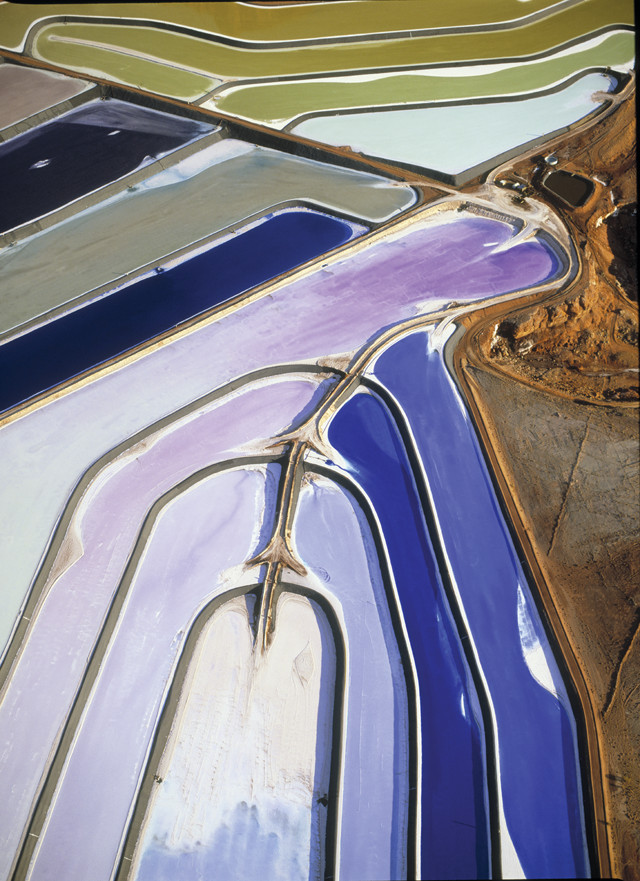
by U.S. Geological Survey Wednesday, June 13, 2018
Stephen M. Jasinski, mineral commodity specialist for the U.S. Geological Survey, has compiled the following information on potash, one of the three essential plant nutrients.

Potassium-salt evaporation ponds where potash is recovered in Utah.
Potash is the generic term for a variety of mined and manufactured salts, all of which contain the mineral potassium in a water-soluble form. Together with nitrogen and phosphate, potash is one of three essential plant nutrients. Potash is used in everything from fertilizers to soaps and detergents, glass and ceramics, dyes, explosives and alkaline batteries. Minor amounts are also used in water softening, sidewalk deicing, and as a table salt substitute. About 85 to 90 percent of potash, however, is consumed for agricultural products.
Potash fertilizers include potassium chloride (also called sylvite in its naturally occurring form), potassium sulfate and potassium-magnesium sulfate. “Muriate of potash” is the name for an agriculturally acceptable fertilizer that combines potassium chloride (95 percent pure or greater), sodium chloride (halite) and minor amounts of other nontoxic minerals from the mined ore. Potash production and nutrient content are expressed in terms of the potassium oxide content.
The majority of world potash resources are found in subsurface bedded salt deposits, which formed when ancient inland oceans evaporated and the contained potassium salts crystallized. Most potash is recovered by underground mining methods. Beneficiated potash ore is sold as a granular product, in several particle sizes. Deposits that are deeper than about 1,100 meters are recovered by solution mining, in which heated water is pumped underground and the resultant brine is pumped to the surface for evaporation and processing.
Mining and processing of potash ore began in Germany in 1860, and potash was first mined commercially on a large scale in the United States in 1931 in New Mexico. The largest deposits of potash are in Canada (Saskatchewan), Russia and Belarus. Potash also is recovered by evaporation from surface brines such as the Great Salt Lake in Utah and the Dead Sea in Israel and Jordan.
Potassium is essential for plant growth, although little of it ends up in the edible portion of the plant. Potassium helps facilitate sugar movement through plants and boosts resistance to stresses, such as drought and disease. Plants take up large quantities of potassium from the soil, and annual applications of potash are necessary to grow crops with the same level of productivity. There are currently no substitutes for potash in agriculture.
Visit minerals.usgs.gov/minerals for more information on potash and other mineral resources.
POTASH PRODUCTION AND CONSUMPTION
U.S. production of potash was 930,000 metric tons potassium oxide in 2010, valued at $660 million.
Potash is produced in the United States from underground mines in New Mexico, solution mines in Michigan and Utah, and surface brines in Utah. Potash deposits in Arizona, Nevada, New Mexico, North Dakota and Utah are under development for solution mining.
Total world production of potash in 2010 was 33.7 million metric tons potassium oxide. Canada, the leading producer with 29 percent of total world production, held 45 percent of world reserves.
Canada, Russia and Belarus accounted for 63 percent of world production in 2010.
China, the United States and India are the leading consumers of potash in the world.
The United States imported more than 80 percent of its potash in 2010, mostly from Canada.
FUN FACTS
Prior to the 1860s, potash was sold as an impure form of potassium carbonate produced from leaching the ashes of hardwood trees in large iron pots, which left a white residue, known as “pot ash.”
The first U.S. patent was issued in 1790 for an apparatus used to produce potash, in the form of potassium carbonate, making potash one of the first industrial minerals to be produced in the United States.
Potash found early use in soap and glass making, fabric dyeing and saltpeter (potassium nitrate) production for gunpowder.
Potash was first discovered to be a plant nutrient in Germany in 1840.
© 2008-2021. All rights reserved. Any copying, redistribution or retransmission of any of the contents of this service without the expressed written permission of the American Geosciences Institute is expressly prohibited. Click here for all copyright requests.